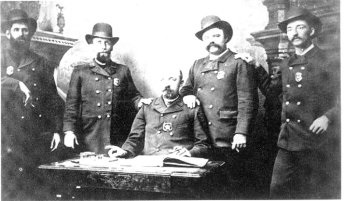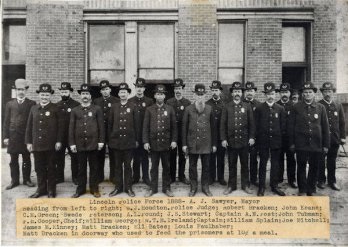1880s
On November 9, 1885, the Council drew up the first set of Official Police Rules, they were:
- Peace and good order was the responsibility of the Marshal.
- Day force on duty from 6am to 7pm. Night force on duty from 7pm to 6am.
- The Patrolman was to be familiar with the beat and it was his duty to guard the same. Use of firearms were allowed only in extreme cases. Police could arrest, without a warrant, anyone found violating city ordinances. In all other cases, a warrant was necessary for an arrest.
- A scrapbook was to be kept at the police station of handbills, telegrams, and photographs of criminals.
- The Patrolmen were to go on duty at such time and place as the marshal might designate.
- Ordinances concerning conduct of saloons were to be strictly enforced.
- Only the Marshal, Captain of Police and Jailer were to have keys to the jail.
- Special police were to make no arrests.
- Police making arrest were entitled to fees if any were paid.
Supervisors shall consist of one Marshal, one Captain of the day force, a Deputy Marshal, and one Captain of the night force. Supervisors were to report for work in uniform and their duty was to see that the above rules were carried out.
If certain charges were sustained against a police officer, they were to be suspended. These charges were:
- Drinking on duty.
- Gossiping about other police.
- Visiting saloons while on duty; except for duty.
- Accepting fees.
- Leaving their beat.
- Visiting a house of ill-fame.
- Willful abuse of a prisoner.
- Uncivil treatment of another officer.
- Immoral conduct.
- Giving information which would allow a criminal to escape.
- Disorderly conduct.
- Sleeping while on duty.

1885 | First known photo of the Lincoln Police Department
Notation on photo "Day Police Force of City of Lincoln on May 1885"
The police department had two shifts, the Day Force and the Night Force. Each shift was 12 hours long and officers worked 7 days a week. Names are written on the bottom of the photograph identifying the men from left to right as: J. Hollaway, J.K. Post, Chief of Police G.B. Beach, M. Smith, and Marian Flowler. Police Chief Beach is seated at the desk.

1888 | Lincoln Police Department standing in front of their office at the City Government Building.
Names listed on the photo are, left to right: Police Judge W.J. Houdton; Robert Bracken; John Keane; C.M. Green; "Swede" Peterson; A.L. Pound; J.S. Stewart; Captain A.M. Post; John Tubman; P.H. Cooper; Chief of Police; William George; W.T.B. Ireland; Captain; William Splain; Joe Mitchell; James McKinney; Matt Bracken; Eli Bates; and Louis Faulhaber. Matt Bracken in doorway who used to feed the prisoners at 10 cents a meal.
In 1889, some of the laws enforced by Lincoln Police were:
SPEED LIMITS
- No person shall ride or drive any horse or other animal in the City of Lincoln with greater speed than at the rate of 6 miles an hour, under the penalty of a fine not more than $20.
- No person, upon turning the corner of any street or crossing the intersection of any street in the City of Lincoln, shall ride with a greater speed than 4 miles an hour. Fine $10.
- Speed in an alley no greater than a walk, fine $15
- Riding on sidewalk, fine $5
- Speed contest; run or race any horse on any public street or road, fine $25
UGLY IN PUBLIC
- Any person who is diseased, maimed, mutilated, or in any way deformed, so as to be an unsightly or disgusting object, or an improper person to be allowed in or on the streets, highways, thoroughfares or public places in this city, shall not therein or thereon expose himself or herself to public view, under the penalty of a fine of $1 for each offense. Upon conviction of any person for violation of this section, if it shall seem proper and just, the fine provided for may be suspended, and such person detained at the police station where he shall be well cared for until he can be sent to the county pool farm.
SUNDAY LAWS | The following activities were deemed unlawful on Sunday:
- Dancing
- Foot races
- Fast driving of horses
- Playing ball
- Ten pins
- Wrestling
- Discharging firearms
- Beating drums
- Fishing
- Boxing
- Playing loud instruments (except at funerals)
- It shall be unlawful to engage in or exhibit any show, play, opera, theater, or public amusement, except in sacred concerts where no admission fee is charged or to use, or permit any licensed hall, opera house, saloon, billiard hall or other place of public amusement to be used on said day.
- It shall be unlawful for any business house, bank, store, saloon, or any office to be open or for any person to be admitted there to for general business on said day. Exceptions - physicians, telegraph, express office, photograph galleries, railroad, telephone and hotels. Fine $5 to $100.